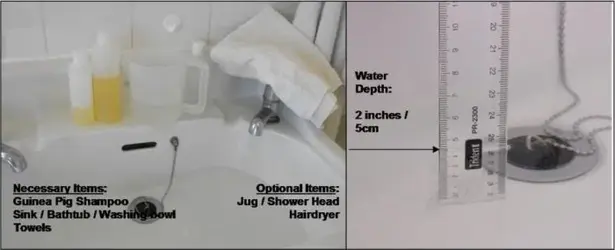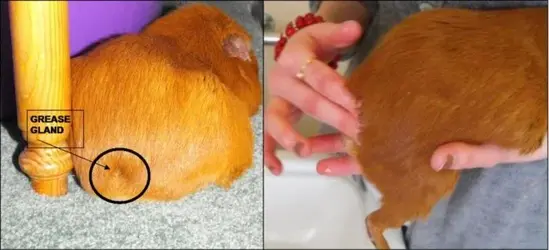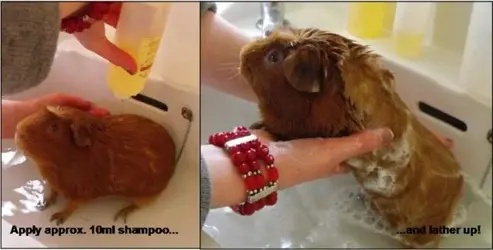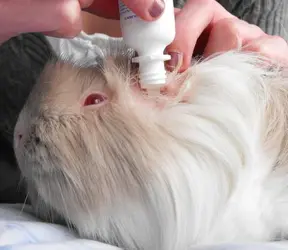Laura-CCC4
Senior Guinea Pig
Do guinea pigs need baths? How? Why? When? What do I use to bath them?
There are many reasons for bathing guinea pigs. It is true that it should not be done too often as excessive bathing can do more harm than good, drying the skin out and stripping the coat of its natural oils. It's best to aim to bath your guinea pigs at least twice a year and particularly when:
a) They have a skin condition requiring bathing e.g. fungal or parasitic;
b) After treating for a parasitic skin problem, to cleanse the skin;
c) They are dirty, especially the long-haired breeds.
There are times when bathing guinea pigs is NOT advised. Specific times include when a guinea pig is suffering a respiratory illness or undiagnosed illness, and during the winter if they live outdoors. The risk of the guinea pig falling ill or having their condition deteriorate is too high in these situations, as they are more susceptible to illness when they are damp.
Just putting the guinea pig in some water and rubbing a bit of shampoo on their back isn't enough to give them a thorough wash, and when you've not bathed a piggie before the prospect of handling a small, wriggling, slippery animal is somewhat daunting!
Before you attempt to bath your guinea pigs, please ensure you read the whole of this article and make sure you set everything up before starting the process being prepared is half the battle!
Setting Up the Bath
As already mentioned, ensure the conditions are right for bathing your piggies. If they are outdoor guineas and it's the middle of winter, then it's probably not a good idea to bath them unless absolutely necessary (i.e. if very dirty or for medical reasons), and even then to ensure the pigs are 110% dry before putting them back outdoors. It is a good idea to bath guineas one at a time, particularly when treating skin complaints, and it can be rather chaotic if you've never bathed multiple pigs before!
First of all, you need to know what is needed to bath guinea pigs, and then how to check that the water is both the right temperature and the right depth. In terms of equipment you need very little; the basics are:
1. A bathtub or washing-up bowl on a water proof surface like a shower, bathroom or kitchen floor. Please do not use a kitchen sink or a bathroom basin; they are too dangerous if a wiggly piggy in a panic jumps blindly from that height! Secure any bowl or any slippery surface the guinea pig sits on during the bathing process with a damp, but not cold, towel for grip.
2. Shampoo
3. Towels for drying - at least two.
Optional extras include a jug or shower head to help rinsing, and a hairdryer to help get the pig dry quicker. It can also help to lay a bath mat or a flannel cloth on the base of the bathtub/washing bowl to prevent the guinea from slipping.
The Setup
There are various setups for bathing guinea pigs, bearing in mind it is necessary to refresh the water after shampooing the guinea pig one lot of water to wash the pig, and one to rinse:
1. Bath in the bowl, and place pig in a carrier/tub while refilling the bowl to rinse.
2. Use two washing bowls
3. Use both the bathtub/shower and the washing bowl
4. Use a washing bowl and the bathtub.
For those new to bathing piggies, I would recommend placing a washing bowl in the bathtub; best to wait until you are confident with handling soggy piggies before you move them where they can hurt themselves!
The Shampoo
The question of what shampoos are safe is a frequent one and a lot comes down to what the individual owner feels is suitable. Which shampoo you choose depends on a number of factors:
a) Are you bathing for medical reasons e.g. to treat a parasitic or fungal problem?
b) Is the guinea pig long-haired? (Is a conditioner needed?)
c) How often are you bathing the guinea pigs?
While many owners will advocate the use of human shampoos, many will also provide opinions on why human shampoos are not ideal for guinea pigs. For this reason, I will list only the most commonly used shampoos formulated for guinea pigs only. The exception to this is those used to treat a specific medical condition where the human shampoo is a safe, effective and frequently-used treatment.
Regular Shampoos:Gorgeous Guineas www.gorgeousguineas.com; Shaws Rabbit & Guinea Pig Shampoo; Johnson's Small Animal Shampoo
Anti-Parasitics*:Lice'n'Easy from Gorgeous Guineas; Fleaordie; Follicel
Anti-Fungals: Imaverol/eniconazole dip (let dry on the skin without rinsing off); Malaseb**; Nizoral (can be rather harsh on the skin)
Suitable Conditioner: see Gorgeous Guineas
*Anti-parasitics are primarily for treating lice; mites should be treated with Ivermectin. For lice, follow up with a conditioner and run through with a nit comb.
** Malaseb is a Prescription-Only Medicine.
The Water
Smaller guineas will obviously need a shallower bath, while the more chunky piggies (with longer legs!) may need the higher end of the guideline. A good general guideline without using measurements, is that when the pig is standing normally, the water would at the very least reach the pigs underside (belly), but NEVER go as high as the chin! It is important that the guinea is able to stand comfortably and does not need to stretch in any way to keep the head out of the water.
To check the temperature, it is much the same as checking if a baby's bathwater is the right warmth. If it feels hot to you, then it is too hot for the guinea; if it feels cold to you, it's too cold for the guinea. Dip your elbow in if you are really unsure, it should simply feel comfortable, neither hot nor cold. One final point before moving onto the how-to: please do ensure that the temperature of the water is even throughout; those without mixer taps can find that there are various cold or hot patches in the water until mixed by hand.
Cleaning the Grease Gland
All guinea pigs have a grease gland located at the base of their spine, roughly where the tail would be if they had one. It is harder to find on some pigs than others, but boars in particular tend to have quite active grease glands, and locating it will be made easier by the greasy circle you can feel - and in some cases see! The photos below show the position of the grease gland.
Cleaning (or checking) the grease gland should be the first thing you do when bathing a guinea pig; removing the grease will ensure the gland stays clean and clear. There have been some cases where a pig's grease gland is so dirty, it actually becomes infected – so there is very good reason to keep a check on things there. A few females have active grease glands, but it's significantly more common for boars to have greasy build-ups here. Normal shampoo will not shift the grease; a product formulated for degreasing is needed. As unlikely as they sound, the three most effective agents for removing this grease are:
1. Coconut oil;
2. Swarfega;
3. Dishwashing liquid (not recommended for regular use, as very skin drying)
The trick is to not lather the product up too much at first; as with very greasy dishes and pots and pans, it's more effective if initially applied neat with very little water involved, then lathered up with a wet sponge or in a guinea pig's case, with wet fingers! After a minute or so of massaging the grease gland, the grease will start to loosen up and you can gently peel/rub the grease off without bothering the pig. Once this is done, you can pop the pig in the water to rinse his rear end off, and then move straight on to actually giving him a bath.
Last edited by a moderator:






